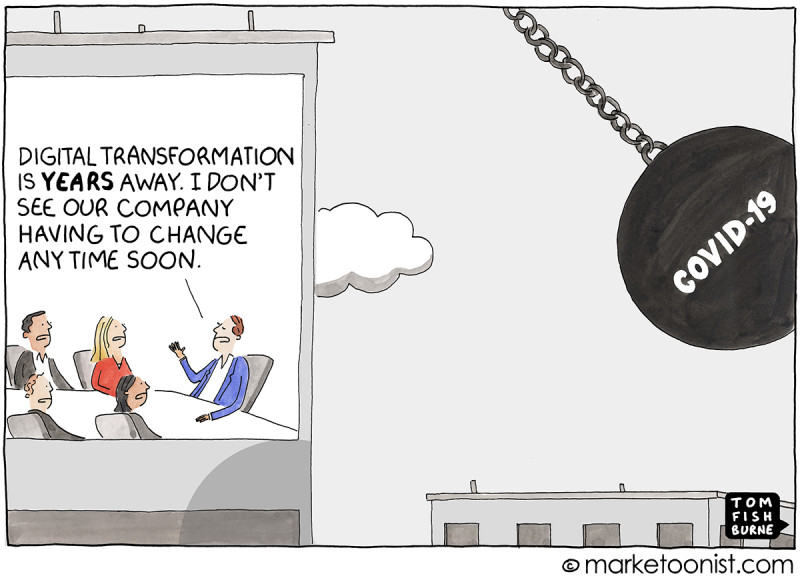
When the world shut itself down in March 2020, the question of whether a digital transformation was necessary was a no-brainer.
If your organization wanted to survive and thrive while everyone was social distancing, you had to take a long, hard look at all of your customer interactions. It made sense to move as many of those interactions online as possible. If not the entire interaction, at least most of it as possible.

In those days, digital transformation bordered on a survival strategy. To move your customer interactions to the digital sphere, you had to change how you run your business.
Now that we’re on the other side of the pandemic and we’re (sometimes begrudgingly) getting back to in-person interaction, the decision to embark on a digital transformation is not so clear. The burning platform of no physical interactions no longer exists, so it doesn’t outweigh the time, cost, and pain that can go along with a digital transformation.
To help you determine if a digital transformation makes sense for your org, here’s a look at what digital transformations are, the pros and cons of digital transformations, and signs you may need a digital transformation at your organization.
What is digital transformation?
Digital transformation is when your organization changes its operations to improve, advance or streamline your existing business processes with digital technologies.Those digital technologies include data, devices, and software which you can use to update how you operate, manufacture, and market products and services.
Digital transformation isn't about minor or incremental improvements. Rather, it’s a significant change to how your organization operates with changes to people, process and technology.
It’s also not a project with a finite ending point. Rather, it's an ongoing effort to change how your business operates. It’s also not something you can do on your own.
Jen Swanson of Tuckpoint Advisors describes digital transformation as "The process of integrating digital technologies into various aspects of a business, which leads to fundamental changes in how the business operates and delivers value to its customers."
It asks us to figure out how technology can and should be leveraged by all corners of the organization. It goes beyond rolling out a digital product or creating a website, challenging organizations to use digital tools, technologies, and strategies to enhance and streamline operations, improve customer experiences, and innovate in new ways.
Such a substantial change can come with significant benefits, but it also comes with some challenges. Here’s some of the key pros and cons of undergoing a digital transformation.

Pros and cons of digital transformation
Pros of digital transformation
There are several aspects of digital transformation that make it worth the effort.
A digital transformation can introduce significant efficiencies to your businesses. When you automate formerly time-consuming and error-prone manual processes, you’ll save time allowing your staff to focus on more business-critical tasks.
This increased efficiency also frees up your staff time for creativity and innovation while reducing operational costs.
If your business is data-rich, adopting the latest digital technologies can help you identify previously hidden market opportunities.
More efficient processes using digital technologies revolutionize how you create products, deliver services, and provide customer support.
Your customers benefit from more streamlined and convenient interactions with your business.
Cons of digital transformation
To go along with all of that upside, there are certainly some cons to undertaking a digital transformation. Here are some of the most significant cons.
Digital transformations require significant financial expenditures to implement the digital technologies and to get help with the transformation itself.
Changing your business processes to use digital technologies can alter or eliminate job roles and devalue certain skill sets leading to internal resistance.
The move to digital processes often requires re-training or up-skilling, and some of your staff may not have the patience or confidence to learn new skills.
Your customers may not want to serve themselves, causing them to look for a different service provider.
Your adoption of digital processes may leave some customers out, especially those who do not have the technology to take advantage of the new processes.
Signs you should undertake digital transformation
With all the upside and downside, you need to make sure a digital transformation makes sense for your organization. Here are some signs that your organization should undertake a digital transformation.
1. Inefficient manual processes
If most of your customer facing processes are manual and involve staff interaction, consider a digital transformation.
Slow, and error prone manual processes can waste staff time and result in long wait times for your customers. Besides inefficiencies, manual processes often introduce errors, which can impact your staff and your customers.
When you can fully integrate your customer facing processes with your back office systems, you can reduce the time those processes take and reduce the chance for errors. For example, an insurance company setup systems to allow customers to file and track their own auto insurance claims online. This move to a digital process reduces the need for staff involvement and reduces the time clients have to wait for help.
2. Customer demands and expectations
If your customers are repeatedly asking for online ways to interact with your organization, consider a digital transformation.
As more and more organizations moved their processes online, customers expect the ability to do just about everything online. Some common examples of interactions that have moved online and structured customer expectations:
Ordering a coffee at Starbucks or a hammer from Home Depot and picking it up in the store, reducing the shopping and waiting time.
Managing all of your financial transactions online so you don’t have to stop at a bank or an atm to deposit a check.
Configuring and purchasing a lawn tractor online and having it available for pickup at your local John Deere dealer.

3. Market competition and disruption
For example, if your organization is an established industry such as insurance or financial services and you’re seeing your market share eroded by new start-ups, consider a digital transformation.
For example, established insurance companies have seen entrants such as Lemonade offer the ability to purchase insurance online and steal customers who attracted to the ease and convenience of the online purchase process.
This has driven those more established insurance companies to investigate how to move their processes online. Often as a result, those companies began digital transformations to increase the agility and innovation in their product development processes.
4. Data and analytics
If your organization wants to make decisions more closely aligned with how your customers behave, do a digital transformation.
If you’ve ever performed any customer or user research, you’ve probably found that what customers say they’ll do often differs considerably from what they actually do. You also may have found that the more information you have about how customers and users behave the better informed you are when making product decisions.
A key benefit of incorporating digital technologies in your processes is the availability of data about your customers and users’ actions. When you can tie information about how your customers reacted to changes you’ve made in your product, you’re in a much better position to make effective product development decisions.

5. Employee productivity and collaboration
If you want to make your staff more effective and improve how they collaborate, undertake a digital transformation.
When you incorporate digital technologies into your business processes, you free up your staff’s time to work on more value added activities.
You also can collect a wealth of information that help your staff to make informed decisions about how they interact with your customers.
You can also employ digital technologies to help your staff collaborate more effectively to make the best use of all the data that your processes generate.
Effective digital transformations require product thinking
When you implement digital technologies as part of a digital transformation, you need to keep your customers front and center. A way to make sure you do that is to adopt a product operating model for all of your digital technology efforts.
As part of that way of working, you need a flexible, modular and easy-to-use tool such as airfocus that gives you a place to focus your product efforts. Discover how airfocus aids your digital transformation efforts.

Kent McDonald

Read also

Create effective product strategy

Experience the new way of doing product management




